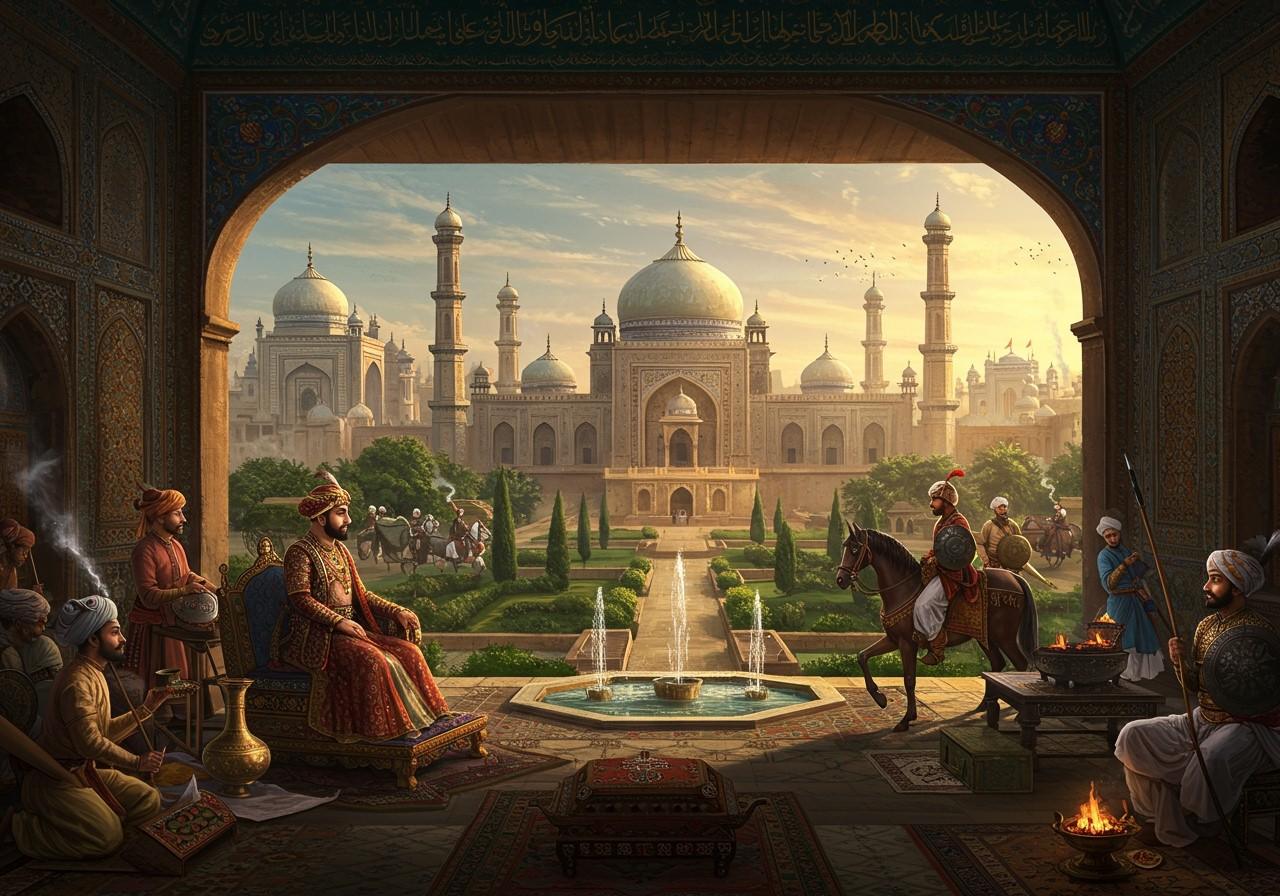
The Deccan Sultanates were influential medieval Indian kingdoms that shaped the Deccan region’s history and culture. By exploring their rise, political dynamics, and cultural impact, we can appreciate the rich heritage that continues to influence modern India.
The Rise of the Deccan Sultanates
Emerging in the 15th century after the decline of the Bahmani Sultanate, five distinct kingdoms arose on the Deccan Plateau in south-central India: Ahmadnagar, Berar, Bidar, Bijapur, and Golconda. Between 1490 and 1492, these sultanates solidified their independence. The Deccan Plateau’s strategic importance facilitated their rise, with local chieftains playing a vital role in unifying diverse ethnic and religious groups. Key figures like Malik Ahmad Nizam Shah and Yusuf Adil Shah were instrumental in consolidating power and establishing these kingdoms.
Political Strategies and Military Might
The Deccan Sultanates engaged in a complex web of political alliances and rivalries, both amongst themselves and with neighboring empires. The Battle of Talikota in 1565 marked a significant turning point, impacting the Vijayanagara Empire and reshaping the balance of power. They employed various strategies, including diplomacy, marriage alliances, and military campaigns, to maintain and expand their territories. Advanced military technology like artillery and gunpowder played a crucial role, influenced by European mercenaries and foreign powers such as the Portuguese.
Cultural and Architectural Achievements
The Deccan Sultanates left an indelible mark on India’s architectural landscape. Iconic structures like the Gol Gumbaz and Charminar stand as testaments to their unique architectural style, blending Persian, Turkish, and indigenous Indian elements. Mosques, palaces, and tombs showcase this fusion of influences. Beyond architecture, the sultans were patrons of the arts, literature, and music. Deccani painting flourished under their patronage, and they promoted Urdu and Persian literature, fostering a vibrant cultural atmosphere. Islamic culture and traditions thrived, and Sufism gained prominence with the establishment of Sufi shrines.
Economic and Social Structures
The economic foundation of the Deccan Sultanates rested on agriculture, trade, and established taxation systems. Major trade routes and vital ports like Surat and Goa facilitated flourishing commerce. Their social structure encompassed a diverse population, including nobility, merchants, artisans, and commoners. Various communities, including Hindus, Muslims, and Jains, coexisted within this multifaceted society. Women held significant roles in both cultural and political life.
Decline and Enduring Legacy
Internal conflicts, succession disputes, and external invasions eventually led to the decline of the Deccan Sultanates. The Mughal Empire, particularly under Aurangzeb’s campaigns, gradually annexed these kingdoms. However, their legacy endures through their remarkable contributions to art, architecture, and the rich tapestry of cultural diversity. Ongoing efforts strive to preserve the historical monuments associated with these sultanates, ensuring that their vibrant history continues to inspire and inform.
Poojn.in: Connecting You to India’s Rich Spiritual Heritage
Poojn.in is dedicated to preserving and promoting India’s rich spiritual traditions, including those that flourished during the time of the Deccan Sultanates. We offer a wide selection of authentic puja items and religious supplies, enabling you to connect with your heritage and practice your faith with reverence.
- Complete Puja Samagri Sets: Perfect for traditional Hindu rituals, our sets contain everything you need for a sacred ceremony. We ensure quality and authenticity in every item.
- Copper and Brass Items: Discover exquisite copper and brass puja items, reflecting the craftsmanship of medieval India. These pieces add a touch of tradition and elegance to your worship space.
- Handpicked Ritual Items: Our experts carefully select ritual items according to ancient Vedic specifications, ensuring their purity and efficacy. We source only the finest materials.
- Genuine Rudraksha Malas: Explore our collection of genuine rudraksha malas and sacred beads, each carrying unique spiritual significance. Find the perfect mala to deepen your practice.
- Traditional Dhoop and Agarbatti: Enhance your puja experience with our traditional dhoop and agarbatti, crafted with natural ingredients. Their fragrant smoke creates a serene atmosphere.
For devotees of Lord Shiva, we offer a curated selection:
- Shiva Lingam for Home Worship: Establish a sacred space in your home with a beautifully crafted Shiva lingam. Choose from various materials and sizes.
- Pure Copper Kalash and Panchpatra: Perform rituals with authentic copper kalash and panchpatra, essential for traditional ceremonies. Their purity enhances the sanctity of your offerings.
- Sacred Thread (Janeu): Honor your faith with sacred threads, meticulously crafted and imbued with spiritual significance. We offer different varieties for various ceremonies.
- Vibhuti (Holy Ash): Receive blessed vibhuti, a symbol of purity and devotion. Use it for tilak and other rituals.
- Crystal Shiva Lingams: Enhance your puja with crystal Shiva lingams, known for their energy and beauty. These exquisite pieces add a special touch to your worship.
- Rudraksha Mala in Various Mukhi Options: Choose from a variety of rudraksha malas with different mukhi (faces), each associated with specific benefits and deities. Find the perfect mala to support your spiritual journey.
Visit www.poojn.in to explore our complete collection of authentic puja items. We offer secure packaging and pan-India delivery, ensuring the sanctity of your religious items. Each product includes detailed information about its ritual significance and proper usage.
Conclusion
The Deccan Sultanates played a pivotal role in shaping medieval India. Their formation, political strategies, and cultural contributions left an enduring legacy. Despite their decline, their influence is still visible today in the Deccan region’s art, architecture, and diverse cultural practices. By understanding their history, we can appreciate the rich heritage they bequeathed to modern India. As we preserve their monuments and traditions, we honor a vibrant past that continues to resonate in the present.


